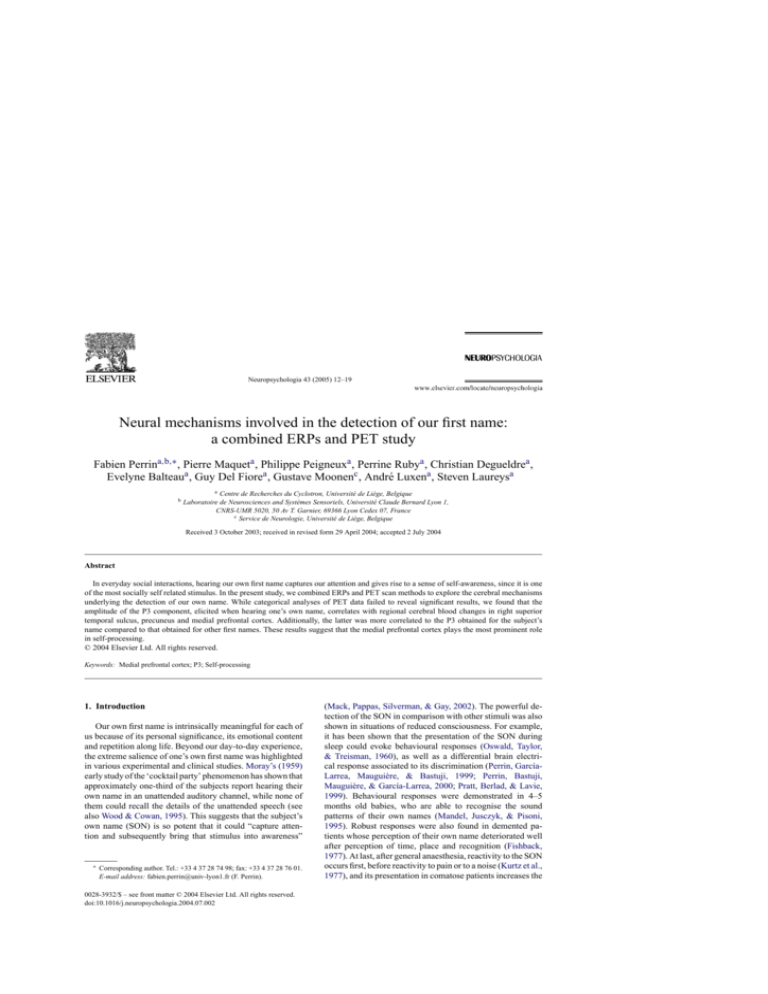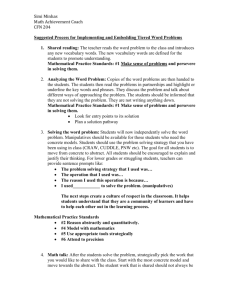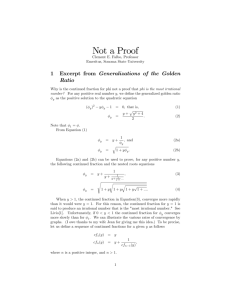
Neuropsychologia 43 (2005) 12–19
Neural mechanisms involved in the detection of our first name:
a combined ERPs and PET study
Fabien Perrina,b,∗ , Pierre Maqueta , Philippe Peigneuxa , Perrine Rubya , Christian Degueldrea ,
Evelyne Balteaua , Guy Del Fiorea , Gustave Moonenc , André Luxena , Steven Laureysa
a
b
Centre de Recherches du Cyclotron, Université de Liège, Belgique
Laboratoire de Neurosciences and Systèmes Sensoriels, Université Claude Bernard Lyon 1,
CNRS-UMR 5020, 50 Av T. Garnier, 69366 Lyon Cedex 07, France
c Service de Neurologie, Université de Liège, Belgique
Received 3 October 2003; received in revised form 29 April 2004; accepted 2 July 2004
Abstract
In everyday social interactions, hearing our own first name captures our attention and gives rise to a sense of self-awareness, since it is one
of the most socially self related stimulus. In the present study, we combined ERPs and PET scan methods to explore the cerebral mechanisms
underlying the detection of our own name. While categorical analyses of PET data failed to reveal significant results, we found that the
amplitude of the P3 component, elicited when hearing one’s own name, correlates with regional cerebral blood changes in right superior
temporal sulcus, precuneus and medial prefrontal cortex. Additionally, the latter was more correlated to the P3 obtained for the subject’s
name compared to that obtained for other first names. These results suggest that the medial prefrontal cortex plays the most prominent role
in self-processing.
© 2004 Elsevier Ltd. All rights reserved.
Keywords: Medial prefrontal cortex; P3; Self-processing
1. Introduction
Our own first name is intrinsically meaningful for each of
us because of its personal significance, its emotional content
and repetition along life. Beyond our day-to-day experience,
the extreme salience of one’s own first name was highlighted
in various experimental and clinical studies. Moray’s (1959)
early study of the ‘cocktail party’ phenomenon has shown that
approximately one-third of the subjects report hearing their
own name in an unattended auditory channel, while none of
them could recall the details of the unattended speech (see
also Wood & Cowan, 1995). This suggests that the subject’s
own name (SON) is so potent that it could “capture attention and subsequently bring that stimulus into awareness”
∗
Corresponding author. Tel.: +33 4 37 28 74 98; fax: +33 4 37 28 76 01.
E-mail address: fabien.perrin@univ-lyon1.fr (F. Perrin).
0028-3932/$ – see front matter © 2004 Elsevier Ltd. All rights reserved.
doi:10.1016/j.neuropsychologia.2004.07.002
(Mack, Pappas, Silverman, & Gay, 2002). The powerful detection of the SON in comparison with other stimuli was also
shown in situations of reduced consciousness. For example,
it has been shown that the presentation of the SON during
sleep could evoke behavioural responses (Oswald, Taylor,
& Treisman, 1960), as well as a differential brain electrical response associated to its discrimination (Perrin, Garcı́aLarrea, Mauguière, & Bastuji, 1999; Perrin, Bastuji,
Mauguière, & Garcı́a-Larrea, 2000; Pratt, Berlad, & Lavie,
1999). Behavioural responses were demonstrated in 4–5
months old babies, who are able to recognise the sound
patterns of their own names (Mandel, Jusczyk, & Pisoni,
1995). Robust responses were also found in demented patients whose perception of their own name deteriorated well
after perception of time, place and recognition (Fishback,
1977). At last, after general anaesthesia, reactivity to the SON
occurs first, before reactivity to pain or to a noise (Kurtz et al.,
1977), and its presentation in comatose patients increases the
F. Perrin et al. / Neuropsychologia 43 (2005) 12–19
chances of obtaining differential brain responses associated
to information processing (Signorino, D’Acunto, Angeleri,
& Pietropaoli, 1995).
The neural correlates of the discrimination of the SON
have not been yet properly investigated. However, some
anatomical hypotheses may be put forward, since hearing
our first name elicits a self-experience, i.e. a “consciousness
of oneself as an immediate subject of experience, unextended
in time” (Gallagher, 2000; for a review see Kircher & David,
2003). This stimulus is of particular interest in the study of
self-processing because its detection is associated with an enhancement of self-awareness. Since it is used by the others to
directly refer to ourself, the SON plays an important part in
our everyday social interactions. For this reason, it can be considered as a very ecological and highly socially self-related
stimulus. Prior neuroimaging studies identified several cortical structures involved in various self-processing: the medial
prefrontal cortex (MPFC) and/or the anterior cingulate cortex, the right temporo-parietal junction and the precuneus.
For instance, MPFC could be involved in tasks where subjects have to make a self-referential judgement (Gusnard,
Akbudak, Shulman, & Raichle, 2001; Lane, Fink, Chau, &
Dolan, 1997) and in tasks requiring (self-)reflection on their
personal abilities, traits or attitudes (Johnson et al., 2002;
Kelley et al., 2000, 2002; Kircher et al., 2001; Kjaer, Nowak,
& Lou, 2002). Activation of all three regions have been described in studies where subjects were implicated in a narrative history, i.e. when they had to take a first-person or a
self-perspective (Vogeley et al., 2001; Vogeley & Fink, 2003).
At last, both MPFC and precuneus were reported to be activated in the conscious resting state (Mazoyer et al., 2001;
Raichle et al., 2001), i.e. in a condition where subjects paid
their attention towards various internal processes. Even if the
resting state is considered by some authors as a behaviourally
ill-defined heterogeneous condition, other suggested that it is
“the ultimate state of inspection of the self” (Wicker, Ruby,
Royet, & Fonlupt, 2003).
The aim of the present study was to identify the cerebral
mechanisms underlying the capacity to discriminate our first
name in the external world. We investigated the P3 (or P300)
potential, for which the parietal component (the ‘P3b’) is enhanced when subjects detect an implicit target stimulus such
as the SON, even in the absence of any explicit instruction
(Berlad & Pratt, 1995; Folmer & Yingling, 1997; Perrin et al.,
1999). We focused our attention on the parietal P3 wave since
its amplitude is sensitive to both task relevance (the SON is
particularly relevant and inherently attended) and stimulus
probability, thus may reflect the information-processing resources allocated to the categorisation/discrimination of the
SON (for a review, see Picton, 1992). Furthermore, we simultaneously acquired positron emission tomography (PET)
images in the aim to identify brain regions in which regional
cerebral blood flow changes correlated with the P3 amplitude
to the SON, i.e. brain areas which were specifically modulated when the resources allocated to detection of the SON
changed.
13
2. Methods
2.1. Subjects
Fifteen right-handed (Edinburgh Inventory, Oldfield,
1971) healthy volunteers (five women, 22.7 ± 3 years)
without hearing deficit and without medical, neurological,
nor psychiatric history participated to the study. The experiment was conducted in agreement with the guidelines
of the ‘Declaration of Helsinki’ and was approved by the
Ethics Committee of the Faculty of Medicine of the University of Liège. Written informed consent was obtained
from all subjects. All subjects had a disyllabic first name,
which was non-commonly used in French language (i.e. employed less than 30,000 times in France during the 20th century: see http://www.prenoms.com/, Kilos Mutimedia Sarl,
IDDN.FR.010.0077897.000.R.P.2000.028.40000).
2.2. Stimuli
Three types of auditory stimuli were used: the subject’s
own name (SON), uncommon first names (UFN), and common first names (CFN, i.e. employed more than 300,000
times during the 20th century).
The experimental material was constructed using a 2 × 2
factorial design, where the type of stimuli (SON versus UFN)
and the probability of occurrence of the first name (20% versus 50%) were independently manipulated. (We did not include a high SON occurrence condition since it would induce
a habituation effect and preclude P300 and related rCBF measurements.) We elaborated four conditions, of 48–60 stimuli,
containing:
(1) SON with a probability of occurrence of 20% and four
CFN with a probability of 20% each [labelled “S20”];
(2) SON at 50% and four CFN at 12.5% each [labelled
“S50”];
(3) UFN at 20% and four CFN at 20% each [labelled “U20”];
(4) UFN at 50% and four CFN at 12.5% each [labelled
“U50”].
The probability of occurrence of the three types of stimuli
was the same within the entire sequence and within the 90-s
period of PET scanning.
The UFN were the first names of the other participants.
Twelve first names were used as CFN and randomly presented across conditions, series and subjects; they were the
same for all participants. Thus, the group comparison of two
conditions eliminated the acoustical effect of all first names.
Moreover, prior to the experiment a list of the five most employed first names, of relatives and friends, was obtained from
each subject and eliminated from the lists.
Each condition was repeated three times and was
randomly presented across subjects. Within each series,
first names were pseudo-randomly presented. SOA was
2000 ms. All first names were recorded by the same
neutral male voice, digitised and replayed binaurally at
14
F. Perrin et al. / Neuropsychologia 43 (2005) 12–19
about 80 dB SPL maximal intensity with Cogent software
environment (Wellcome Department of Imaging Neuroscience, London, UK, http://www.vislab.ucl.ac.uk/Cogent/).
All were disyllabic and had a maximum length of
600 ms.
Subjects were instructed to listen passively and to remain
attentive to the stimuli all along the recording session. We
did not use an active attention task in the aim to further apply
this protocol in subjects with altered states of consciousness
(such as coma, general anaesthesia, sleep, dementia, minimally conscious state, etc.).
2.3. ERPs, PET and MRI acquisitions
Electroencephalographic (EEG) signals from nine AgCl
electrodes (Fz, Cz, Pz, F3, C3, P3, F4, C4, P4), placed according to the International 10–20 system (Jasper, 1958;
Klem, Lüders, Jasper, & Elger, 1999) and referenced to the
nose, electrooculogram (EOG) from two electrodes diagonally above and below the right eye, and electrocardiogram
(ECG) from two electrodes on pectoral muscles, were amplified (150,000×) and sampled at 1000 Hz by a Synamps acquisition system connected to a Neuroscan (NeuroSoft, Sterling,
VA, USA) equipment, with an analog bandpass of 0.1–70 Hz.
A ground electrode was placed near Fpz and impedance was
kept below 5 k.
After the installation of the electrodes, the subject was
installed on the (PET) scanner couch. Her/his head was stabilised by a thermoplastic facemask. A venous catheter was
inserted in a left anterobrachial vein and two earphones
were inserted into the external acoustic canals. PET data
were acquired on a CTI 951 R 16/31 scanner in threedimensional mode (Siemens, Erlangen, Germany). Cerebral
blood flow was estimated while subjects listened to names
in one of the four conditions. Each scan consisted of two
frames: a 30-s background frame and a 90-s frame. The
slow intravenous water (H2 15 O) infusion begun just before
the second frame. Six millicurie (222 MBq) were injected
for each scan. The infusion was totally automated. Data
were reconstructed using a Hanning filter (cut-off frequency
0.5 cycle/pixel) and corrected for attenuation and background
activity.
Structural T1-weighted MRI scans were obtained by an
Allegra 3 T MR (Siemens, Erlangen, Germany) at a [0.9 mm
× 0.9 mm × 0.9 mm] voxel size (MPRAGE, TR = 1960 ms,
TE = 4.43 ms, FA = 8◦ ).
2.4. ERPs data analyses
The EEG analysis was conducted on the stimuli presented during PET scanning (i.e. the 90-s frame). Individual
event-related potentials (ERPs) were analysed over a 1700 ms
epoch, including a prestimulus baseline of 200 ms, and averaged according to the condition (S20, S50, U20, and U50),
the type of stimulus (SON or UFN and CFN) and the electrode position. Prior to averaging, single epochs containing
eye movement or muscular artefact with amplitude exceeding ±50 V were excluded from the average. Then, ERPs
were averaged across subjects and digitally filtered between
0.1 and 30 Hz (roll off: 24 dB/oct.) to create grand-averaged
ERPs (used for illustrative purposes). Statistical computations were performed on averaged traces from each individual: amplitudes (from baseline) and latencies of the N1, P2,
N2 and P3 components were calculated for each individual
average. These values were tested with a three-way analysis
of variance (ANOVA) with repeated measures on the type of
first names (SON or UFN versus CFN), the condition (S20
versus S50 versus U20 versus U50) and the electrode position (Fz versus Cz versus Pz). Post-hoc Bonferroni tests
were performed when significant interactions emerged on
ANOVA.
The difference in P3 amplitude between the SON or the
UFN and the CFN was calculated for each individual average
at its maximum, i.e. at Pz, and these values were used as
covariate of interest in the subsequent SPM analyses.
Separate ANOVAs were performed to test the existence
of laterality effects on the P300 under our experimental
conditions. P300 amplitudes were submitted to similar repeated measurements ANOVAs than described above, but
using lateral temporal electrodes (T3 and T4) as levels for
the ‘electrode position’ factor. For all analyses, no significant effect nor interactions were noted for the electrode side factor, and therefore further analyses were restricted to midline electrodes in order to maximise the
P300 effect, which is known to predominate over the
midline.
2.5. PET data analyses
PET data were analysed using the statistical parametric mapping software SPM99 (Wellcome Department
of Cognitive Neurology, London, UK, http://www.fil.ion.
ucl.ac.uk/spm/) implemented in MATLAB (Mathworks,
Sherborn, MA). For each subject, all scans were realigned
together, normalised and smoothed using a Gaussian kernel
of 16-mm full width at half maximum.
The scan condition, covariate (P3), condition by covariate interaction and subject effects were estimated according to the general linear model (only one design matrix was
constructed). Changes in global CBF were taken into account by a subjects specific ANCOVA. Areas of significant
changes were determined using linear contrasts of condition
estimates.
We first assessed the main effects of first name presentation independently of the probability of occurrence
[(S20–U20) + (S50–U50) and (U20–S20) + (U50–S50)],
those of the probability of occurrence independently of the
type of first name [(S50–S20) + (U50–U20) and (S20–S50)
+ (U20–U50)] and the interactions between factors. Then,
we looked for the simple effects of the type of first name
(SON or UFN) at each probability of occurrence (S20–U20,
S50–U50, U20–S20 and U50–S50).
F. Perrin et al. / Neuropsychologia 43 (2005) 12–19
Furthermore, we looked for the brain areas that covaried
with the P3 amplitude obtained when subjects heard their
own first name (SON) or an uncommon first name (UFN) at
both probabilities of occurrence (S20 + S50 and U20 + U50).
We also looked for the brain areas that were more correlated
to the P3 amplitude obtained for the SON than that obtained
for the UFN [(S20 + S50) − (U20 + U50)].
The resulting set of voxel values for each contrast constituted a map of the t statistic, SPM (T), thresholded at
P(uncorrected) ≤ 0.001. Results were considered significant at P < 0.05 after a small volume correction of 10-mm
radius-sphere centred on the predetermined regions of interest. The latter were the medial prefrontal cortex (stereotaxic
coordinates x = ±6, y = 54, z = 11, averaged coordinates
taken from Gusnard et al., 2001; Johnson et al., 2002; Kelley
et al., 2002; Lane et al., 1997; Mazoyer et al., 2001; Raichle
et al., 2001; Vogeley et al., 2001), the right temporo-parietal
junction (x = 58, y = −56, z = 28, Kjaer et al., 2002;
Vogeley et al., 2001) and the precuneus (x = ±6, y = −52,
z = 45, Kelley et al., 2002; Kircher et al., 2000, 2002; Kjaer
et al., 2002; Johnson et al., 2002; Mazoyer et al., 2001;
Raichle et al., 2001; Vogeley et al., 2001). Functional results were positioned on the averaged structural MRI of our
subjects.
15
3. Results
3.1. ERPs data
Four event-related potentials were recorded to first name
stimuli and labelled N1, P2, N2 and P3 (Fig. 1). They respectively peaked at about 110, 200, 280 and 400 ms. ANOVA
failed to demonstrate any significant difference in N1, P2
or N2 amplitudes or latencies between stimuli names in any
condition.
Conversely, ANOVA showed that the electrode position
had a significant effect on P3 amplitude (F(2,28) = 64, P =
0.000000) reflecting its maximal scalp distribution over Pz
site (Fig. 1). Furthermore, the analysis demonstrated that the
type of first names, the condition and their interaction had
significant effects on P3 amplitude (respectively F(3,42) =
5.30, P = 0.003; F(1,14) = 50.17, P = 0.000005; F(3,42) =
5.58, P = 0.003). Post-hoc analyses revealed that P3 amplitude was significantly greater when presenting the subjects’
own first name (SON) than when presenting the common first
names (CFN) in the S20 and S50 conditions (P < 0.005 for
both analyses), but that there was no P3 difference in amplitude between the uncommon first names (UFN) and the CFN
in the U20 and U50 conditions (P > 0.05).
Fig. 1. Grand-averaged auditory evoked potentials of 15 subjects to hearing their own name (SON: thick traces) or an uncommon first name (UFN: thick traces)
and to the other first names (CFN: thin traces) in the four conditions: S20 (when SON had a probability of 20% and CFN of 20%), S50 (when SON at 50% and
CFN at 12.5%), U20 (when UFN at 20% and CFN at 20%) and U50 (when UFN at 50% and CFN at 12.5%). Traces of the two types of names are represented
at Fz, Cz and Pz.
16
F. Perrin et al. / Neuropsychologia 43 (2005) 12–19
Table 1
Brain areas where rCBF was linearly correlated to the P3 response evoked by hearing one’s own first name
Region
Brodmann area
x (mm)
y (mm)
z (mm)
Z value
Small volume corrected P-value
Right medial prefrontal cortex
Left precuneus
Right superior temporal sulcus
10
7
39
8
−6
64
64
−66
−58
12
48
28
3.66
3.17
3.16
0.006
0.023
0.023
Right medial frontal cortex
10
8
64
16
3.88
0.003
The last line corresponds to the brain area which is more correlated to the P3 response obtained for the subject’s own name than that obtained for another first
name (x, y and z are coordinates in the standard Talairach and Tournoux (1988) stereotactic space).
3.2. PET data
3.2.1. Effects of the type of name and of the probability
of occurrence
Categorical comparisons based on the stimulus type (SON
versus UFN) or its probability of occurrence (20% versus
50%) failed to reveal significant effects in regions of interest
(even after a small volume correction centred on the predetermined regions of interest). These analyses did not include the electrophysiological measures. Thus, it could be
suggested that PET data alone are less adapted to assess the
brain responses to sparse events, as in the passive detection
of the SON (in particular with our protocol in which similar
conditions, except for one stimulus, were contrasted).
3.2.2. Areas varying with the P3 amplitude
The SPM analysis looking for brain areas that showed a
linear correlation between rCBF and the amplitude of the P3
responses identified four clusters: right medial prefrontal cortex, left precuneus, right superior temporal sulcus and right
intraparietal sulcus (P(uncorrected) < 0.001; the search volume the whole brain). Given that the right intraparietal sulcus (x = 34, y = −66, z = 22) was not part of our a priori
hypotheses, it is only reported for completeness but will not
be discussed further. The three other regions corresponded to
the a priori selected brain areas, which were predicted to participate to the discrimination of the SON. They were found
significantly activated (see Table 1), at P < 0.05 after a small
volume correction, when we looked for the regions in which
regional cerebral blood flow (rCBF) covaried with the P3 at
both probabilities of occurrence (S20 + S50). This analysis
revealed significant linear regressions (ρ > 0.5, P < 0.05)
between the P3 values obtained in these two conditions and
rCBF in the right medial prefrontal cortex (Fig. 2a), the right
posterior end of the superior temporal sulcus (Fig. 2b), near
the temporo-parietal junction (when superimposing on indi-
Fig. 2. Cerebral areas where rCBF showed a significant correlation with P3 amplitude when subjects heard their own first name: (a) the right medial prefrontal
cortex, (b) the right posterior ending of the superior temporal sulcus, and (c) the left precuneus (P < 0.05, corrected at the voxel level).
F. Perrin et al. / Neuropsychologia 43 (2005) 12–19
vidual MRI, the activation was in the angular gyrus for three
subjects), and the left precuneus (Fig. 2c).
Finally, the condition [(S20 + S50) versus (U20 + U50)]
by covariate (P3 amplitude) interaction identified the medial
prefrontal cortex as the only brain area where the response
to the P3 was significantly larger for the SON than for the
UFN.
No correlations between P3 values and any brain region
was observed for UFN.
4. Discussion
The present study was designed to identify the brain areas
that were involved in the detection of the subject’s own name
(SON), i.e. a word that induces a self-referential process,
independently of its probability of occurrence in the series.
The introduction of a sensible electrophysiological correlate
of the identification of one’s own first name, i.e. the P3 component, allowed us to identify the brain structures which are
modulated when the resources allocated to the discrimination
of the SON changed.1
First, a linear regression between P3 amplitude and regional cerebral blood flow (rCBF) changes was observed
in the right medial prefrontal cortex (MPFC) when subjects
heard sequences containing their own first name. This activation is consistent with neuropsychological studies, which
showed that impairments of self-awareness or self-reflection,
as well as incapacity to reflect on personal knowledge, occur more frequently following medial prefrontal damage than
other regions (Ackerly & Benton, 1947; Damasio, Trenel,
& Damasio, 1990; Stuss, 1991; Wheeler, Stuss, & Tulving,
1997). Neuroimaging studies have also reported the activation of the MPFC during tasks involving self-processing,
i.e. self-reflection, self-perspective and free thoughts. For instance, in the study of Gusnard et al. (2001), subjects had to
make two judgements in response to pleasant versus unpleasant pictures (i.e. self-referential) and indoors versus outdoors
pictures (i.e. not self-referential). The authors showed that
the self-referential task was associated with activity along the
dorsal MPFC. The MPFC was also selectively engaged when
subjects had to make self-referential judgements about trait
adjectives (i.e. self-referential processing) as compared to
when they had to make case judgements (Kelley et al., 2002).
The same region was involved when subjects responded to
statements requiring knowledge of, and reflection on, their
own abilities, traits and attitudes, i.e. self-reflective thought
(Johnson et al., 2002). Taking a self-perspective (i.e. being
the agent of an history) also activated MPFC (labelled by
the authors anterior cingulate cortex [x = 6, y = 54, z = −4])
(Vogeley et al., 2001). At last, the activation of the MPFC
was described in studies dealing with the conscious resting
1 The present study allowed us to identify the brain structures which are
modulated by the occurrence of the SON but not those which are responsible
of the generation of the P3 wave.
17
state, i.e. free thought (Mazoyer et al., 2001; Raichle et al.,
2001), a brain state which “instantiates functions that are integral to the self” (Gusnard et al., 2001). In our study, the
hemodynamic response in the MPFC was more correlated to
the P3 amplitude in the context of SON processing than by
any other first name [significant (S20 + S50) versus (U20 +
U50) by P3 interaction]. Thus, since one’s own name is one
of the most socially self related stimuli, this result suggests
that MPFC seems involved in self-processing.
Second, a significant regression with P3 was observed in
the right superior temporal sulcus, activated when subjects
were asked to think intensely on how they would describe
the personality traits and physical appearance of themselves
(Kjaer et al., 2002). This region was also described when
subjects read stories that induced a self-perspective (Vogeley
et al., 2001). However, the involvement of this region in firstperson perspective processing appears to be rather complex
since the right temporo-parietal junction was also detected
in third-person perspective processing, either motor (Ruby
& Decety, 2001) or conceptual—’theory of mind’ (Frith &
Frith, 1999; Ruby & Decety, 2003). The apparent paradoxical
involvement of the right temporo-parietal junction in both
self and other processing suggests that this region is involved
when subjects have to make a distinction between self and
other but is not specific to one of the two processes.
Third, covariations between P3 amplitude and rCBF were
observed in the precuneus. This is consistent with many previous neuroimaging studies on self-processing (self-reflection:
Kircher et al., 2000, 2002; Kjaer et al., 2002, self-perspective:
Vogeley et al., 2001 and free thoughts: Mazoyer et al., 2001;
Raichle et al., 2001) and on third-person perspective (see,
for example, Ruby & Decety, 2001). In a broader perspective, this region seems to play a central role in the different
states of consciousness. It is one of the most active cerebral
regions in conscious waking (Andreasen et al., 1995) and one
of the least active in states of altered consciousness. Indeed,
rCBF decreases were observed in this region during paradoxical and slow-wave sleep (for a review, see Maquet, 2000), in
vegetative state patients (Laureys et al., 1999), in the hypnotic
state (Maquet et al., 1999) and in general anaesthesia (Alkire
et al., 1999; Fiset et al., 1999; Kaisti et al., 2002). Thus, the
modulation of consciousness associated to the modulation
of activity in the precuneus suggests that this region participates in the neural network subserving conscious perception.
The present paradigm does not permit to disentangle explicit
from implicit detection of the SON; further researches should
answer to this question.
At last, our results show a possible predominant role of the
right hemisphere in self-processing. While previous work has
also reported a right dominance related to activation of the
superior temporal sulcus (Kjaer et al., 2002; Vogeley et al.,
2001), results are inconsistent for the frontal cortex: some
authors stipulated that the right prefrontal cortex may play
a stronger role than the left in self processing (for example, Keenan et al., 2000), other claimed the opposite (for
example, Turk et al., 2002). In our study, the right hemi-
18
F. Perrin et al. / Neuropsychologia 43 (2005) 12–19
spheric dominance is probably linked to the emotional importance of the SON, in line with previous studies suggesting
that the right hemisphere is determinant in emotion processing (see, for example, Adolphs et al., 1996; Schwartz et al.,
1975).
In conclusion, the present study illustrates the interest of
combining ERPs and PET scan methods, since the cerebral
basis of the discrimination of the SON could be highlighted
only by introducing the P3 covariate. Moreover, we demonstrated for the first time that the electrophysiological manifestations of the detection of one’s own name, i.e. the P3
potential, correlate with neural activity measured in medial
prefrontal cortex. Future studies could use this approach to
evaluate the residual self-awareness in states of altered consciousness (i.e. coma, vegetative state, sleep or general anaesthesia).
Acknowledgements
The research has been supported by a Tom Slick Research
Award, Mind Science Foundation, Texas, USA, the Fonds
National de la Recherche Scientifique de Belgique (FNRS),
the Fondation Médicale Reine Elisabeth (FMRE) and the Research Fund of the University Hospital CHU, Sart Tilman,
Liège. Fabien Perrin was supported by the Fondation Fyssen
and by Marie Curie Individual Fellowship, Philippe Peigneux
by PAI/IAP P5/04 and Steven Laureys and Pierre Maquet are,
respectively, Research Associate and Research Director at the
FNRS. We thank C. Phillips, E. Salmon and S. Brédart for
helpful comments and J. Hodiaumont, P. Hawotte and J.-L.
Genon for technical assistance.
References
Ackerly, S. S., & Benton, A. L. (1947). Report of case of bilateral frontal
lobe defect. Research Publications: Association for Research in Nervous and Mental Disease, 27, 479–504.
Adolphs, R., Damasio, H., Tranel, D., & Damasio, A. R. (1996). Cortical
systems for the recognition of emotion in facial expressions. Journal
of Neuroscience, 16, 7678–7687.
Alkire, M. T., Pomfrett, C. J., Haier, R. J., Gianzero, M. V., Chan, C.
M., Jacobsen, B. P., et al. (1999). Functional brain imaging during
anesthesia in humans: Effects of halothane on global and regional
cerebral glucose metabolism. Anesthesiology, 90, 701–709.
Andreasen, N. C., O’Leary, D. S., Cizadlo, T., Arndt, S., Rezai, K.,
Watkins, G. L., et al. (1995). Remembering the past: Two facets of
episodic memory explored with positron emission tomography. American Journal of Psychiatry, 152, 1576–1585.
Berlad, I., & Pratt, H. (1995). P300 in response to the subject’s own name.
Electroencephalography & Clinical Neurophysiology, 96, 472–474.
Damasio, A. R., Trenel, D., & Damasio, H. (1990). Individuals with
sociopathic behavior caused by frontal damage fail to respond autonomically to social stimuli. Behavioural Brain Research, 41, 81–94.
Fiset, P., Paus, T., Daloze, T., Plourde, G., Meuret, P., Bonhomme, V., et
al. (1999). Brain mechanisms of propofol-induced loss of consciousness in humans: A positron emission tomographic study. Journal of
Neuroscience, 19, 5506–5513.
Fishback, D. B. (1977). Mental status questionnaire for organic brain
syndrome, with a new visual counting test. Journal of the American
Geriatrics Society, 25, 167–170.
Folmer, R. L., & Yingling, C. D. (1997). Auditory P3 responses to name
stimuli. Brain & Language, 56, 306–311.
Frith, C. D., & Frith, U. (1999). Interacting minds—A biological basis.
Science, 286, 1692–1695.
Gallagher, S. (2000). Philosophical conceptions of the self: implications
for cognitive science. Trends in Cognitive Sciences, 4, 14–21.
Gusnard, D. A., Akbudak, E., Shulman, G. L., & Raichle, M. E. (2001).
Medial prefrontal cortex and self-referential mental activity: Relation
to a default mode of brain function. Proceedings in the National
Academy of Sciences of the United States of America, 98, 4259–
4264.
Jasper, H. H. (1958). Report of the commitee on methods of clinical examination in electroencephalography. Electroencephalography & Clinical Neurophysiology, 10, 370–375.
Johnson, S. C., Baxter, L. C., Wilder, L. S., Pipe, J. G., Heiserman, J. E.,
& Prigatano, G. P. (2002). Neural correlates of self-reflection. Brain,
125, 1808–1814.
Kaisti, K. K., Metsahonkala, L., Teras, M., Oikonen, V., Aalto, S.,
Jaaskelainen, S., et al. (2002). Effects of surgical levels of propofol and sevoflurane anesthesia on cerebral blood flow in healthy subjects studied with positron emission tomography. Anesthesiology, 96,
1358–1370.
Kelley, W. M., Macrae, C. N., Wyland, C. L., Caglar, S., Inati, S., &
Heartherton, T. F. (2002). Finding the self? An event-related fMRI
study. Journal of Cognitive Neuroscience, 14, 785–794.
Keenan, J. P., Wheeler, M. A., Gallup, G. G., Jr., & Pascual-Leone,
A. (2000). Self-recognition and the right prefrontal cortex. Trends in
Cognitive Sciences, 4, 338–344.
Kircher, T. T., Senior, C., Phillips, M. L., Benson, P. J., Bullmore, E. T.,
Brammer, M., et al. (2000). Towards a functional neuroanatomy of
self processing: Effects of faces and words. Cognitive Brain Research,
10, 133–144.
Kircher, T. T., Senior, C., Phillips, M. L., Rabe-Hesketh, S., Benson, P. J.,
Bullmore, E. T., et al. (2001). Recognizing one’s own face. Cognition,
78, B1–B15.
Kircher, T. T., Brammer, M., Bullmore, E. T., Simmons, A., Bartels,
M., & David, A. S. (2002). The neural correlates of intentional and
incidental self-processing. Neuropsychologia, 40, 683–692.
Kircher, T. T., & David, A. S. (2003). The self in neuroscience and
psychiatry. Cambridge: Cambridge University Press.
Kjaer, T. W., Nowak, M., & Lou, H. C. (2002). Reflective self-awareness
and conscious states: PET evidence for a com-mon midline parietofrontal core. NeuroImage, 17, 1080–1086.
Klem, G. H., Lüders, H. O., Jasper, H. H., & Elger, C. (1999). The
ten–twenty electrode of the international federation. In G. Deuschl &
A. Eisen (Eds.), Recommendations for the practice of clinical neurophysiology: Guidelines of the international federation of clinical
neurophysiology (pp. 3–6). Amsterdam: Elsevier.
Kurtz, D., Trapp, C., Kieny, M. T., Wassmer, J. M., Mugnaioni, M. D.,
Pack, A., et al. (1977). Study of recovery and the post-anaesthetic period. Revue d’Electroencephalographie & Neurophysiologie Clinique,
7, 62–69.
Lane, R. D., Fink, G. R., Chau, P. M., & Dolan, R. J. (1997). Neural
activation during selective attention to subjective emotional responses.
NeuroReport, 8, 3969–3972.
Laureys, S., Goldman, S., Phillips, C., Van Bogaert, P., Aerts, J., Luxen,
A., et al. (1999). Impaired effective cortical connectivity in vegetative
state: Preliminary investigation using PET. NeuroImage, 9, 377–382.
Mack, A., Pappas, Z., Silverman, M., & Gay, R. (2002). What we see:
Inattention and the capture of attention by meaning. Consciousness &
Cognition, 11, 488–506.
Mandel, D. R., Jusczyk, P. W., & Pisoni, D. B. (1995). Infants’ recognition
of the sound patterns of their own names. Psychological Science, 6,
314–317.
F. Perrin et al. / Neuropsychologia 43 (2005) 12–19
Maquet, P., Faymonville, M. E., Degueldre, C., Delfiore, G., Franck, G.,
Luxen, A., et al. (1999). Functional neuroanatomy of hypnotic state.
Biological Psychiatry, 45, 327–333.
Maquet, P. (2000). Functional neuroimaging of normal human sleep by
positron emission tomography. Journal of Sleep Research, 9, 207–231.
Mazoyer, B., Zago, L., Mellet, E., Bricogne, S., Etard, O., Houde, O.,
et al. (2001). Cortical networks for working memory and executive
functions sustain the conscious resting state in man. Brain Research
Bulletin, 54, 287–298.
Moray, N. (1959). Attention in dichotic listening: Affective cues and the
influence of instructions. Quarterly Journal of Experimental Psychology, 11, 56–60.
Oldfield, R. C. (1971). The assessment and analysis of handedness: The
Edinburgh inventory. Neuropsychologia, 9, 97–113.
Oswald, I., Taylor, A. M., & Treisman, M. (1960). Discriminative responses to stimulation during human sleep. Brain, 80, 440–453.
Perrin, F., Garcı́a-Larrea, L., Mauguiere, F., & Bastuji, H. (1999). A
differential brain response to the subject’s own name persists during
sleep. Clinical Neurophysiology, 110, 2153–2164.
Perrin, F., Bastuji, H., Mauguiere, F., & Garcı́a-Larrea, L. (2000). Functional dissociation of the early and late portions of human Kcomplexes. NeuroReport, 11, 1637–1640.
Picton, T. W. (1992). The P300 wave of the human event-related potential.
Journal of Clinical Neurophysioogy, 9, 456–479.
Pratt, H., Berlad, I., & Lavie, P. (1999). ‘Oddball’ event-related potentials
and information processing during REM and non-REM sleep. Clinical
Neurophysiology, 110, 53–61.
Raichle, M. E., MacLeod, A. M., Snyder, A. Z., Powers, W. J., Gusnard,
D. A., & Shulman, G. L. (2001). A default mode of brain function.
Proceedings in the National Academy of Sciences of the United States
of America, 98, 676–682.
Ruby, P., & Decety, J. (2001). Effect of subjective perspective taking
during simulation of action: A PET investigation of agency. Nature
Neuroscience, 4, 546–550.
19
Ruby, P., & Decety, J. (2003). What do you believe versus what
do you think they believe: A neuroimaging study of conceptual
perspective taking. European Journal of Neuroscience, 17, 2475–
2480.
Schwartz, G. E., Davidson, R. J., & Maer, F. (1975). Right hemisphere
lateralization for emotion in the human brain: Interactions with cognition. Science, 190, 286–288.
Signorino, M., D’Acunto, S., Angeleri, F., & Pietropaoli, P. (1995). Eliciting P300 in comatose patients. Lancet, 345, 255–256.
Stuss, D. T. (1991). Disturbance of self-awareness after frontal system
damage. In G. P. Prigatano & D. L. Schacter (Eds.), Awareness of
deficit after brain injury: Clinical and theorical issues (pp. 63–83).
New York: Oxford University Press.
Talairach, J., & Tournoux, P. (1988). Co-planar stereotaxic atlas of the
human brain 3-dimensional proportional system: An approach to cerebral imaging. Stuggart: Georg Thieme Verlag.
Turk, D. J., Heatherton, T. F., Kelley, W. M., Funnell, M. G., Gazzaniga,
M. S., & Macrae, C. N. (2002). Mike or me? Self-recognition in a
split-brain patient. Nature Neuroscience, 5, 841–842.
Vogeley, K., Bussfeld, P., Newen, A., Herrmann, S., Happe, F., Falkai,
P., et al. (2001). Mind reading: Neural mechanisms of theory of mind
and self-perspective. NeuroImage, 14, 170–181.
Vogeley, K., & Fink, G. R. (2003). Neural correlates of the first-personperspective. Trends in Cognitive Sciences, 7, 38–42.
Wheeler, M. A., Stuss, D. T., & Tulving, E. (1997). Toward a theory
of episodic memory: The frontal lobes and autonoetic consciousness.
Psychological Bulletin, 121, 331–354.
Wicker, B., Ruby, P., Royet, J. P., & Fonlupt, P. (2003). A relation between rest and the self in the brain? Brain Research Review, 43, 224–
230.
Wood, N., & Cowan, N. (1995). The cocktail party phenomenon revisited:
How frequent are attention shifts to one’s name in an irrelevant auditory channel? Journal of Experimental Psychology: Learning, Memory
& Cognition, 21, 255–260.








